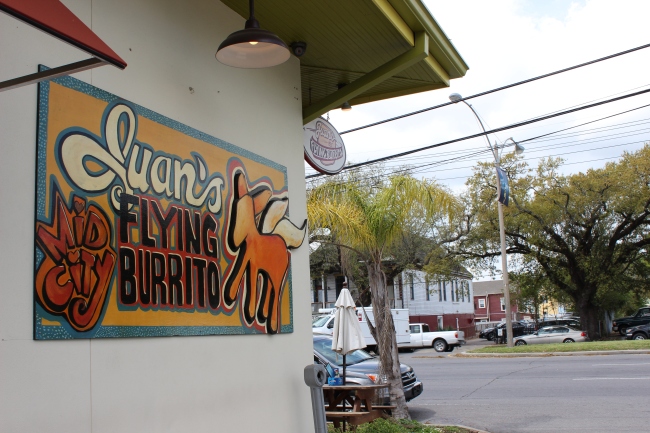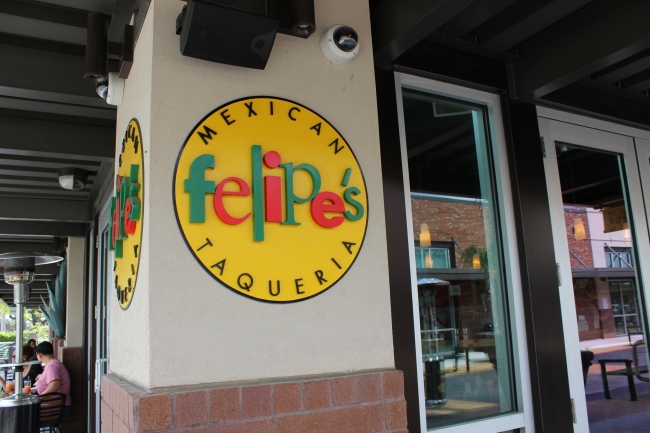Friday – March 16, 2012 – Interview with Frank Barrera
In theory, our research project on the Restaurant Row should be easy for us budding food anthropologists – particularly those of us who are locals. After all, a common phrase heard in New Orleans is “we don’t eat to live, we live to eat”.
The “natives” among us should know all there is to know about navigating our way in and out of the social spaces we find ourselves dining in as part of our research. Theory is one thing but practice is another.

Front door to the bar at El Rinconcito
I called Frank Barrera, owner of El Rinconcito, a few times over the last couple of months but he was always busy- he just did not have the time to give an interview to a nosy young man (or anthropologist… this quality often goes hand in hand). Truth be told, it was harder than I expected for me to explain why I wanted to interview him about El Rinconcito. While there are specific things the Restaurant Row Recovery Project hopes to find, I realized that making our research goals clear was easier said than done.
I’m a college student and he’s a restaurant owner; the community dynamics that either one of us sees in some ways are very different from one another. While we may call the Canal/Carrollton area the Restaurant Row, the restaurant owners probably don’t; we bring our perspectives of the area to the area that we’re studying. Our different worldviews and experiences sometimes lead us to be “lost in translation” even though we’re speaking the same language to one another. All was not lost, I promise.

Entrance to the Dining Area of El Rinconcito
I did finally get to interview Frank Barrera to ask him more about El Rinconcito and the Restaurant Row. If anything, after talking to Frank, I realized how much he goes out of his way for his workers, clients, and those interested in his restaurant in one way or another. While he doesn’t have a website yet, he told me that anyone can reach him by e-mail if someone has any questions about the restaurant or menu.

The bar at El Rinconcito
I arrived about an hour earlier than we had scheduled to meet and talk. This time I went to the bar. It’s interesting how much different the bar experience is from the dining one. On the bar, I saw painted LSU, Tulane, fleur-de-lis(es?), and Saints helmets. There were two TVs: one at the bar and one close to the windows overlooking N. Carrollton. One was giving highlights of the soccer world while the over was playing music videos of Mexican pop stars. The clientele was a mix of both working-class Latinos and Americans.
I was dressed up more than usual and, in some ways, this made me stand out more- a dressed up young man with a laptop drinking water at the bar. I was clearly a little out of place. I thought this would allow me to be taken more seriously and it may have. I’ll ask Frank next time. Just let me believe my fashion sense that day paid off.
When Frank arrived, I could tell he was busy. He had brought some supplies with him and he started to talk to the bartenders and cooks. I waited awhile before I approached him but once I saw he was ready, I let him know I was the nosy anthropologist who had been calling him for the last couple of months.
While I’m the type who likes to dabble in the small details of stories or discuss the particularities of things, Frank likes to get straight to the point. He told me from the get-go that he could only do the interview for a short while cause he was busy, but he was very courteous and took me seriously. Although I could go into a lot more detail about the particularities of how and why El Rinconcito came to be a part of the Restaurant Row, I’ll try and brief the bloggers.

Dining Area of El Rinconcito
Frank is an incredibly interesting as well as hardworking person. He was born and raised in Colombia and learned how to cook at home with his mother. He moved to the US in 1962 and has lived in many different parts of the US including Texas, New Jersey, Florida, and Louisiana. He has held a large variety of jobs during that time. While crossing the country during his stint as a truck driver, he passed through New Orleans a few times. He loved the parades and how “small” New Orleans was in the 1970’s so much he decided to move here.
He has owned and operated a variety of different businesses while living in New Orleans. In 1995, he leased and operated what was once the Home Plate Inn on Tulane Ave. He changed the name to La Finca Home Plate Inn that was a restaurant for some time. He still uses this name for his limited liability corporation (LLC) that includes El Rinconcito and La Finca Home Plate Inn (which is now a weekend night club). He also stills drives taxis around town.
When I talked to him more specifically about El Rinconcito, I asked him a variety of questions about its history and the surrounding community. Before El Rinconcito, the building used to serve as an antique store and restaurant that served Chinese food. He doesn’t remember its name.
The main reason Frank chose to open El Rinconcito in 2006 on N. Carrollton was because it was a busy street that was lacking a restaurant that served Latin American food. In the immediate aftermath of Hurricane Katrina, he said that he had the only restaurant open in the area and served hundreds of people everyday. In addition to that, he loves parades and he felt this wouldn’t hurt his business either since some of them run right through N. Carrollton during Mardi Gras.
Frank has lived in Metairie most of his life since 1976 when he first moved to New Orleans. When I asked him more about his clientele, he told me that he does have quite a number of regulars that come to the restaurant or bar. He said the majority of his customers are people from all over Latin America. Despite this fact, he made it very clear to me that he tries to appeal to everyone.

One of the more interesting things about El Rinconcito is that it claims to be an “American” and “Spanish” restaurant. Interestingly enough, Frank and I were both in agreement that the food at El Rinconcito is clearly much more Latin American. Frank explains it this way, “Come and ask for any food and we will make it for our customers. That’s the main reason I advertise food this way”.
He backed it up by telling me a few stories. He told me of instances where he cooked pork chops or even hamburgers for his customers who weren’t interested in what’s on the menu. Other times, he said that his customers might have a different take on what should be in an enchilada or burrito. He tries to make them the way his customers would like.
What Frank likes about running El Rinconcito on the Restaurant Row is simple. He has good customers and no one really gives him any trouble. He has a cordial relationship with the other restaurants in the area but is not incredibly close to them. He says his main goal is to serve his customers right.
When I asked Frank about his feelings on the construction of the Mid-City Market and the Lafitte Corridor, he remains positive for the future of the area. He feels that it is better to have new businesses come into the area to get rid of the blight and to attract new customers. To Frank, these new developments pose only new opportunities for El Rinconcito, not obstacles.
Before starting the interview, I showed Frank the first blog. Overall, he appreciated it but he did mention one flaw in what I had written. Once again, the word “rumbo” came up. He mentioned to me that my translation of El Rinconcito motto is a little off. He told me that rumbo, in this context, is really more along the lines of giving to others. A better translation of the experience to be found at El Rinconcito might be this: “No somos los mejores pero sí los mejores del rumbo.” – “We’re not the best but we give the best service.”
PS- More on Kjeans later!





































 Photo borrowed from:
Photo borrowed from: 
